Can You Paint a Bathtub? A Step-by-Step Guide With Tips for Painting
When you're remodeling a bathroom, the idea of replacing a bathtub might feel overwhelming - especially when you factor in the cost and hassle of ripping it out and hauling in a new one. But what if you didn’t have to replace it? What if you could simply paint your old bathtub and give it a fresh, updated look? Yes, it’s possible! Let’s explore the ins and outs of painting a bathtub and whether it’s the right solution for your home makeover.
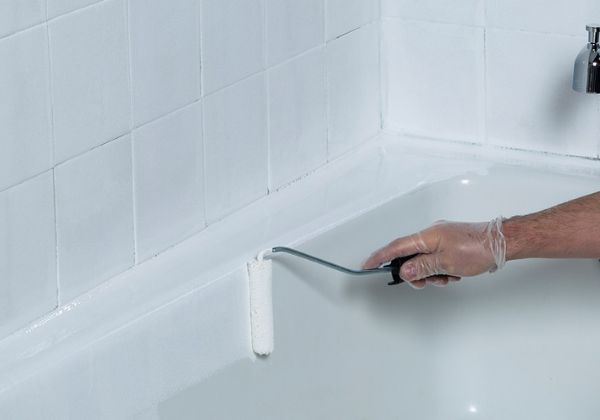
Can You Paint a Bathtub?
The short answer is yes—you can absolutely paint a bathtub. But, like any DIY project, it comes with its pros and cons. Bathtub refinishing kits have made it easier than ever to paint a tub yourself, and professionals also offer refinishing services for those who want a more polished result. The key is knowing what material your bathtub is made of and choosing the right paint for the job.

Understanding Bathtub Materials
Before you start dreaming of a perfectly painted tub, it's important to understand what type of material your bathtub is made from. Not all tubs are created equal, and different materials respond differently to paint.
Can You Paint Porcelain Bathtubs?
Porcelain bathtubs are quite common, especially in older homes. Luckily, porcelain is one of the easiest materials to refinish. With the right prep work, you can paint a porcelain bathtub and achieve a durable, long-lasting finish. The next question is “what paint to use for bathtub painting?” Just be aware that the process involves using specialized paint made for this type of material, and a strong primer is essential for ensuring the paint adheres well.
Can You Paint Acrylic or Fiberglass Bathtubs?
Acrylic and fiberglass tubs are popular in modern homes due to their lightweight nature and affordability. While these materials can also be painted, the process is a bit trickier than with porcelain. Acrylic and fiberglass are slick surfaces, so you’ll need to use a bonding primer to help the paint stick properly. Additionally, these materials may require more frequent touch-ups over time as they are prone to chips and scratches.
Limitations of Painting Metal or Cast-Iron Bathtubs
Metal and cast-iron bathtubs are incredibly durable, and many older homes feature these heavy-duty fixtures. While painting these tubs is possible, it’s not without its challenges. Cast iron and metal require thorough sanding and a special primer that can handle the metal’s tendency to rust. Additionally, these tubs can take longer to paint and cure due to their dense material. However, if done correctly, the results can be stunning and last for years.
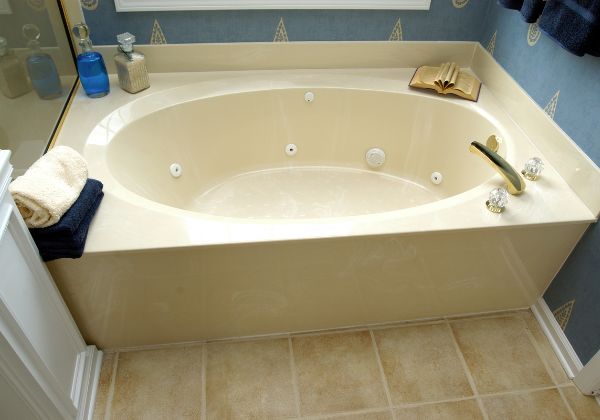
Pros and Cons of Painting Your Bathtub
Now that you know it's possible to paint your bathtub, let's weigh the pros and cons to help you decide if it's worth the effort.
Benefits of a DIY Bathtub Paint Job
One of the biggest perks of painting your bathtub is cost savings. Replacing a bathtub can cost anywhere from $1,000 to $3,500 or more, depending on your location and the complexity of the installation. Painting allows you to change the look of your tub without the hassle of a full bathroom renovation.
If you're looking for a budget-friendly, quick fix and are confident in your DIY skills, a refinishing kit may be the way to go, as a painting kit costs between $25 and $100. But if you're aiming for a more polished, professional result or have a worn-down tub that needs serious attention, it might be worth investing in a professional service. While you’ll pay more (typically $300 to $600), a professional will ensure a flawless finish with long-lasting durability. They have access to higher-grade materials and equipment that aren't readily available to the public, and they know how to handle tricky surfaces like cast iron or fiberglass with expert precision.
Another advantage? It's relatively quick. While the painting process itself may take a few hours, most of the drying and curing time happens over the next few days. So, you can avoid living with a construction zone in your bathroom for weeks on end.
Potential Risks and Drawbacks
While painting a bathtub is a tempting option, it’s important to be aware of the potential downsides. Here are some key risks to consider:
- Temporary Solution - Bathtub paint is not permanent and may chip or peel over time, especially with frequent use. DIY jobs often need touch-ups sooner than professional finishes.
- Surface Prep is Critical - Poor surface preparation can lead to peeling or chipping. Thorough cleaning, sanding, and priming are essential for proper adhesion.
- DIY Durability - DIY refinishing kits are generally less durable than professional-grade materials and may not last as long, particularly with heavy use.
- Strong Fumes - Paints and chemicals used in the process can release strong fumes. Proper ventilation is crucial, and professionals have better safety equipment.
- Inconsistent Finish - DIY applications can result in uneven paint, streaks, or drips. Professionals provide a more polished and uniform finish.
- Long Curing Time - It can take 48 hours or more for the paint to dry and up to a week to fully cure, meaning your bathtub will be unusable during this time.
- Limited Color Choices - DIY kits typically offer limited color options, whereas professionals can offer a wider variety.
- Underlying Issues - Painting won’t solve problems like rust, cracks, or mold, which may worsen over time if not properly addressed.
- Time and Effort - Painting a bathtub requires significant prep work, time, and effort. It’s not always a quick or easy project, especially for beginners.
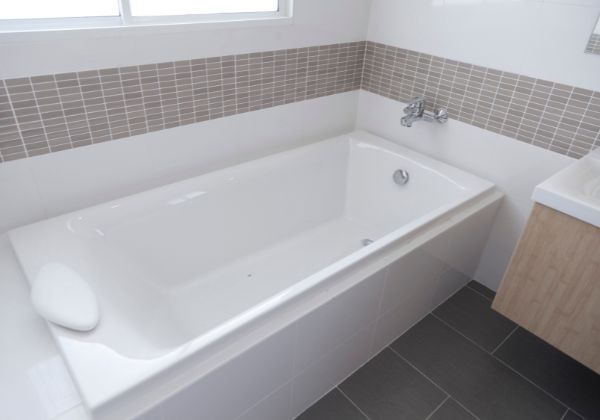
How to Paint a Bathtub: A Step-by-Step Guide
Ready to roll up your sleeves? Here's how to tackle a bathtub painting project step by step.
Tools and Materials You Will Need
- Bathtub refinishing kit (includes bonding primer, paint, and topcoat)
- Painter’s tape
- Sandpaper (usually 400-600 grit)
- Respirator or mask
- Cleaning supplies (like a tub and tile cleaner)
- Sponge or cloth
- Paint roller, paint brushes or spray applicators
- Rust-oleum (optional)
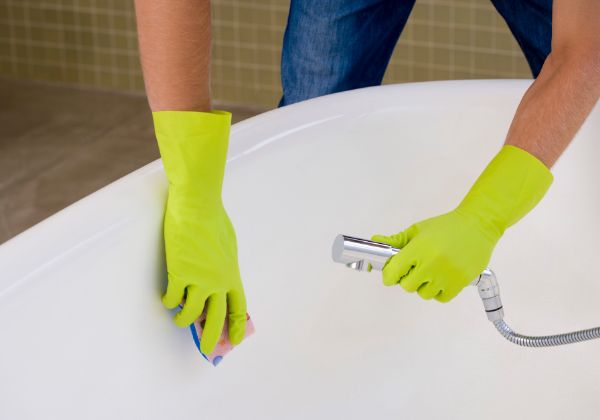
Preparing Your Bathtub for Painting
The key to a successful paint job is preparation. Here’s how to get your tub ready.
Cleaning and Sanding the Surface
Start by cleaning your bathtub thoroughly. You’ll want to remove any soap scum, mold, or grime using a tub cleaner. After the surface is spotless, sand it down to create a rough texture that will allow the paint to adhere better. Be sure to wipe away any dust from sanding around the bathtub before moving on.
Masking and Protecting Surrounding Areas
Tape off any areas around the tub that you don’t want to paint, including faucets, tiles, and floors before painting the tub. Using painter’s tape and plastic sheeting will help protect everything else in your bathroom from splatters.
Applying the Paint
Once your bathtub is prepped and your space is protected, it’s time to paint!
Choosing the Right Paint for Your Bathtub
Not just any paint will do. You'll need a paint designed specifically for tubs and tiles. Choosing the wrong type for your bathtub can lead to peeling, chipping, or a finish that doesn’t last. For bathtub refinishing, you'll need a paint specifically formulated for high-moisture, high-wear environments like bathrooms.
Typically, epoxy-based paints are the best choice. Epoxy paints are highly durable, water-resistant, and can handle daily exposure to hot water, soap, and cleaning products without breaking down. They bond well to surfaces like porcelain, fiberglass, and acrylic, providing a strong, long-lasting finish.
Acrylic polymer paints are another option, often used by professionals. These offer a durable and glossy finish but may require a primer for the best adhesion. The benefit of acrylic-based options is their resistance to yellowing over time, a common issue with older epoxy formulations.
It’s also important to consider whether you’re using a brush-on paint or a spray-on finish. Spray paints offer a smoother, more even coating with fewer visible brush marks but require more precision and protective measures to avoid overspray.
When selecting paint, also think about your bathtub’s material. Different materials (like porcelain, acrylic, fiberglass, or cast iron) might require specific formulations or primers for optimal adhesion. Reading the manufacturer’s guidelines for compatibility will help ensure you choose the right product for your specific tub.
Lastly, check if the paint is rated for resistance to chemicals used in cleaning products. A paint that can withstand regular cleaning without deteriorating will help your bathtub’s new look last much longer.
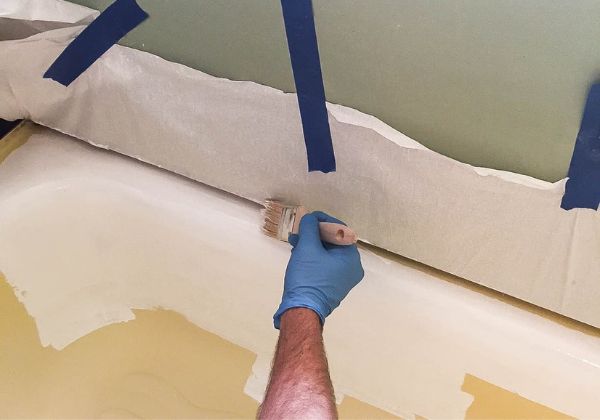
Step-by-Step Application Process
Step 1: Start with the bonding primer to ensure the paint adheres properly. Apply the primer according to the manufacturer’s instructions.
Step 2: After the primer dries, it’s time to apply the paint. Use a brush or a sprayer for even coverage. Depending on the kit you purchased, you might need two or three coats.
Step 3: Once the paint has dried, apply the topcoat to seal in your work and provide extra durability.
Post-Painting Care and Curing Time
After you’ve painted the bathtub, patience is key. Proper drying and curing are essential to ensure long-lasting results.
Allow the bathtub to dry for at least 24 to 48 hours before using it, and wait at least a week for the paint to fully cure before taking long baths or filling the tub with water. This will help the paint set properly and avoid premature peeling or chipping.

Maintenance Tips for Painting to Get Long-Lasting Results
After painting your bathtub, proper care is essential to maintain its appearance and extend the lifespan of the finish. Here are some key maintenance tips to keep your bathtub looking fresh for years to come:
- Use Non-Abrasive Cleaners - Opt for gentle, non-abrasive cleaners to prevent scratching or dulling the paint. Avoid scouring pads and gritty cleaners.
- Avoid Harsh Chemicals - Steer clear of bleach, ammonia, or acidic cleaners that can wear down the paint. Mild soap and water or a gentle tub cleaner work best.
- Clean Regularly - Regular cleaning prevents soap scum, mold, and grime from building up, keeping the finish in good condition. Wipe down the tub after each use to minimize residue.
- Avoid Heavy Impacts - Prevent dropping heavy objects into the tub, as they can cause chips or cracks in the painted surface.
- Keep Water from Pooling - Standing water can weaken the paint over time. Ensure proper drainage and wipe away excess water after use to protect the finish.
- Address Minor Chips Quickly - If you notice small chips or scratches, touch them up with paint before they expand or worsen, preserving the overall finish.
- Avoid Hot Water Soaking Immediately - Wait at least a week after painting before filling the tub with hot water. This allows the paint to fully cure and bond to the surface.
- Ventilate After Use - Keep your bathroom well-ventilated after using the tub to reduce moisture buildup, which can affect the paint’s longevity.
Choosing The Best Paint for Bathtubs: Our Top Recommendations
Here are some key features to look for when selecting the right bathtub paint:
Key Features to Look for in Bathtub Paint
- Durability: Look for paints that are specifically made for high-moisture areas like bathrooms.
- Water-resistance: Ensure the paint is waterproof and mold-resistant.
- Ease of application: Some paints are easier to apply than others, so read reviews or instructions carefully before choosing.
Frequently Asked Questions About Painting Bathtubs
How long does bathtub paint last?
A well-done DIY paint job can last between 3-5 years, while professional refinishing might last up to 10 years. It depends on how well the surface is prepped and maintained.
Can you use regular household paint for bathtub?
No, using regular household paint on a bathtub is not recommended. Household paints, even those labeled as "water-resistant," are not designed to withstand the constant exposure to moisture, hot water, and cleaning chemicals that a bathtub endures. Regular paint will likely peel, chip, or blister very quickly due to the harsh environment.
Instead, you'll need to use special tub and tile paint that’s specifically formulated for high-moisture areas. These paints, often epoxy-based or acrylic polymer-based, are designed to bond with materials like porcelain, acrylic, and fiberglass, creating a durable, waterproof barrier. This type of paint is tough enough to handle everyday wear, including exposure to soaps, shampoos, and cleaners, while maintaining its finish for years.
How much does it cost to paint a bathtub?
DIY kits range from $25 to $100, while professional refinishing costs between $300 and $600, depending on your location and the size of the tub.
Can you paint any type of bathtub material?
Most bathtubs can be painted, but the method and paint type will vary depending on the material. Always check what your tub is made of before starting.
What type of paint is best for bathtubs?
Choosing the right type of paint is crucial for achieving a durable, long-lasting finish for bathtubs:
- Epoxy-based paints - These are widely regarded as the best option for this task and are specifically designed to withstand the high moisture and constant wear that bathtubs experience. Epoxy paints create a strong, water-resistant coating that adheres well to various surfaces, such as porcelain, acrylic, and fiberglass.
- Specialized bathtub refinishing kits - Another excellent choice, these kits typically include epoxy-based paints or other formulations designed for tub and tile applications. They often come with everything you need for the project, including primer, paint, and applicators, ensuring a comprehensive solution tailored for bathtub refinishing.
- Acrylic polymer paints – There are options in acrylic polymer paints that are particularly designed for high-use areas. They offer good durability and resistance to yellowing over time, though they might not be as robust as epoxy-based options. Acrylic paints can be a suitable choice if you prefer a faster-drying option with a variety of finishes.
How do I maintain a painted bathtub to ensure long-lasting results?
Use gentle cleaners, avoid abrasive scrubbing pads, and keep the tub dry when not in use to help preserve the finish of your bathtub.
Conclusion
Painting your bathtub can be an affordable and effective way to give your bathroom a fresh look without undergoing a full bathtub remodel. While the process does take some effort, the cost savings and quick transformation make it a great option for many homeowners. Whether you decide to tackle it yourself or hire a professional, be sure to follow all the steps carefully to ensure that your new paint job lasts.
Remodel Your Home connects you with the best experts for your bathroom remodel project in your location. We ensure that our vendors, with the right expertise, tools, and knowledge, help you breathe new life into your bathing space!

Remodel Your Home
We are a leader in the home improvement space with over 20 years of experience pairing homeowners with construction experts.
About Us